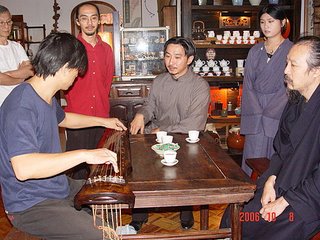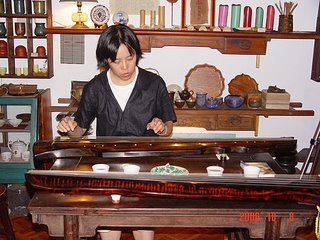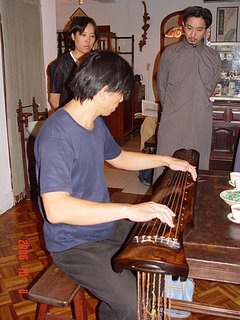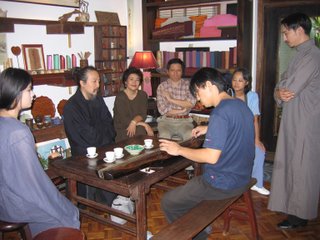|
and the 9 virtues which distinguish the Qin 辨琴之九德 The host of Ye Tang, Mr. He Jian 何建 is a very generous person who let us use his space without charging us any fee and even served us very good tea. I appreicated that. Mr. He has very good sense of tea and his place is not on a big street. Only people who know him will visit his store and buy his tea and tea pots... The address of Ye Tang, Hu Cha Kong Jian (Pots Tea Space) 冶堂 壺茶空間 台北市永康街三十一巷二十之二號一樓 20-2, 1st FL. Lane 31, Yong Kang Street, Taipei, Taiwan. R.O.C. TEL: 02-33938988  From the left to the right: Mr. He Jian, Mr. Liu Shan-wei, Mr. Liu Xingyi, Mr. Zhen Dexuan, Renee and Jung Ping.    Below are the 9 virtues which distinguish the Qin I had just read in Zunsheng Ba Jian by Ming dynasty Gao Lian: (According to Qin Fu 琴府 p.1747, the 9 virtues which distinguish the Qin was mentioned the earliest in the Song dynasty by Tian Zhi-ong. 田芝翁) 明 高濂的遵生八牋提到的辨琴之九德: 1, Qi (Remarkable) which means Qin (light) Song (free, not held) Cui(clear) Hua(smooth). Qin indicates that the wood is light. Song indicates that the sound is not held. Cui indicates that the sound is clear and venerable, because of the old tong wood. Hua indicates that the sound is sweet and mellow, because of the wood was grown near water. 一曰奇 輕鬆脆滑是也 輕謂材輕 鬆謂聲透 脆謂聲之清老 老桐木也 滑謂聲之澤潤 近水材也 2, Gu (Ancient) which means simple, pure yet contains the rhymes of bell and chime. 二曰古 淳淡中有金石韻也 3, Tou (Penetrated) which means an old qin where the adhesives and lacquer are dried and the sound quality is clear bright and not held. 三曰透 年雖久遠 膠漆不敗 清亮而不咽塞 4, Jin (Quiet) which means that there is no buzzing sound to influence the proper sound quality of the Qin 四曰靜 謂無(先文)飒以亂正聲 5, Run (Moist) which means that the sound quality comes out not dry and the rhythm stays longer. 五曰潤 謂發聲不燥 韻長不絕 6, Yuan (Whole) which means that the sound and rhythm stay as a whole without breaking up 六曰圓 謂聲韻渾然而不破散 7, Qin (Clear) which means that the sound of the qin comes out clearly as the sound of a big bronze Duo bell in wind. 七曰清 謂聲如風中鐸也 8, Yun (Even) which means that all the sound qualities, open string, press down string and harmonics from each of the seven strings has to be regular, steady and smooth. 八曰勻 謂七弦無三實四虛之病 9, Fang (Fragrant) which means a good qin the more its been played the better the sound quality, like a pleasant fragrance which stays long and doesn't lose it's flavor. 九曰芳 謂愈彈愈發 久無乏聲 | ||
Back To Main Menu | Back To Previous Page | ||